“Fried Rice Paradise” was the title track of Dick Lee’s 1973 debut album – a cheeky, upbeat ode delivered in unapologetic Singlish. When it first aired on radio in the late 1970s, it was reportedly banned for using too much Singlish – a telling sign of how local expression, much like our local cuisine, once struggled for legitimacy in a society that prized polish over authenticity.
And yet, over time, the song became a cult classic – beloved for its charm, wit, and proud embrace of Singaporean flavour. Like the food it celebrates, it wasn’t refined by global standards – but it was unmistakably ours.
Riding across rural roads and border towns on a motorcycle, I’ve eaten at places you won’t find on food blogs or Instagram feeds – where recipes aren’t followed, they’re remembered. Each bite along the way made me ponder where our food culture once was, and where it’s heading. I found myself chasing not just flavours, but the fading ambience of smoky kitchens, enamel plates, and voices calling out orders in dialects that are growing quiet. Those moments stirred a deeper question about what we’re losing – and what we’ve already lost.
It’s these reflections – stirred by the road, and seasoned by time – and it’s these flavours, memories, and quiet questions that inspired this journey through words.
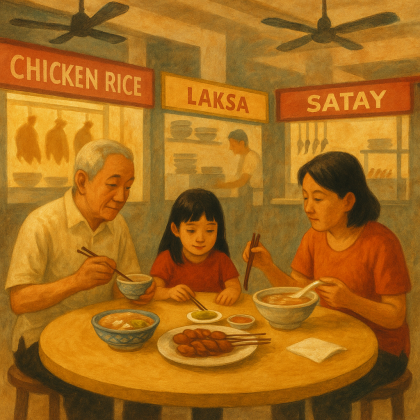
where Every Bite Tells a Story
Embarking on a culinary journey through the vibrant streets of Singapore – and further across the rich tapestry of Southeast Asia – one quickly discovers that the essence of life here is savoured in every delectable bite. In this gastronomic haven, where flavours dance on the taste buds and food is more than a necessity, it becomes an art, a ritual, and for many, the purest joy of daily life.
Singapore’s food culture is more than what’s served on the plate – it’s a social glue, a shared vocabulary of hawker stalls, kopi tiam, and late-night supper rituals. It’s no surprise that our hawker culture was awarded a coveted spot on the UNESCO Representative List of the Intangible Cultural Heritage of Humanity. But accolades, however prestigious, can also freeze a living culture into something to be admired rather than actively nurtured.
Our beloved hawker centres – once alive with the rhythm of spirited aunties, uncles, and sizzling woks – are quietly falling out of favour with the younger generation. Many now gravitate toward mass commercialisation and polished franchises, drawn by their air-conditioned comfort, sleek branding, and perceived modernity. As the old masters retire, their stalls are too often left unfilled – not by local successors, but by new immigrant-run eateries introducing cuisines from abroad. The gritty traditional flavours we once took for granted are steadily being edged out – not just by fading memory, but by shifting social dynamics and evolving demographics. The question then looms: will the next generation remember how we used to eat – or only what replaced it?
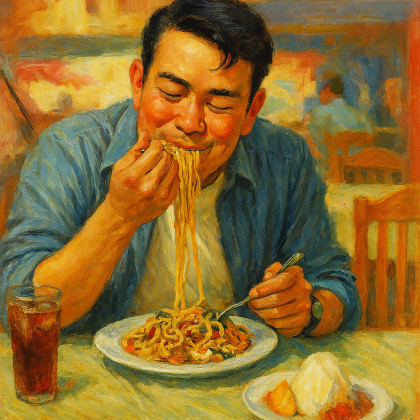
The Unique Flavours of Home
The cuisines of Nanyang (南洋) a historical term for the southern maritime region spanning the South China Sea and the archipelagos of Southeast Asia – reflect generations of migration, cultural blending, and culinary ingenuity. What we often think of as traditional food here is, in fact, deeply regional and uniquely local.
Hainanese Chicken Rice, though originally inspired by Wenchang chicken (文昌雞) from Hainan – the home province of many early Hainanese immigrants – was refined and popularised in Singapore into something quite distinct: poached chicken, fragrant rice cooked in chicken fat, and a trio of accompanying sauces. It owes much of its modern fame to Peter Gehrmann, an alum of The Savoy in London and Executive Chef of The Mandarin Singapore when Chatterbox debuted in 1971, who helped bring the dish to international attention. Ironically, this now-iconic dish is virtually unrecognisable in its place of origin and cannot be found there in the form we know today. Nonya cuisine, born from the intermarriage of Chinese and Malay communities, created iconic hybrids like laksa and ayam buah keluak. Bak Kut Teh (肉骨茶), widely associated with the Nanyang Chinese, developed into distinct regional varieties far removed from any single origin.
Dishes like Chilli Crab, Black Pepper Crab, Nonya Kueh, Ayam Buah Keluak, Nasi Lemak, and Nasi Kandar are iconic examples of this region’s rich culinary tapestry. The Malay and Indian kitchens in this region contributed their own spirit of adaptation, giving rise to beloved dishes such as Mee Rebus, Mee Soto, Roti Jala, Fish Head Curry, Roti Prata (or Canai), Roti John and Murtabak. Over time, even local communities began cross-mixing culinary influences, creating a uniquely blended cuisine that reflects the vibrant, evolving food culture of Southeast Asia.
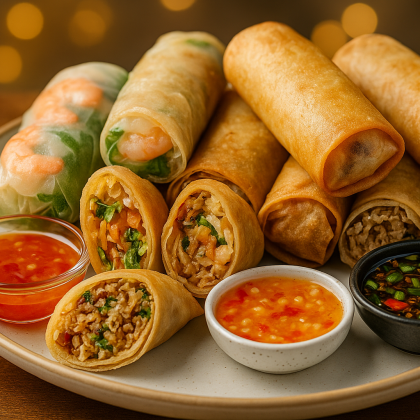
Food, Identity, and the Borders We Inherit
Food has the power to evoke identity, pride, and even patriotism – but it also reminds us how porous culture really is. Dishes like Popiah and Lumpia, which have sparked online debates over their origin, are perfect examples. In 2015, protesters in Indonesia staged a rally outside the Malaysian Embassy in Jakarta, condemning a move by the neighbouring country to claim Lumpia as a national dish. Yet both share the same ancestral root – brought to the region centuries ago by Chinese migrants, long before Indonesia, Malaysia, or Singapore existed as nations.
Even their names suggest a shared lineage: Lumpia are Indonesian and Filipino adaptations of the Fujianese (Hokkien) lūn-piá(潤餅) and Teochew popiah(薄餅).
This culinary overlap is far from unique. Across Asia, spring rolls have taken on many distinct local identities. In the Philippines, Lumpia is typically deep-fried and crisp. In Myanmar, Kyat thar palata (ကြက်သားပလာတာ) and other variants are also deep-fried, spiced with local seasonings. Thailand’s Poh Pia Tod (ปอเปี๊ยะทอด) features tighter rolls, usually paired with sweet chili sauce. In Vietnam,Gỏi cuốn – a distinctly Vietnamese creation – is served cold, wrapped in delicate rice paper and filled with herbs, vermicelli, and shrimp or pork. Cambodia offers Nime chao (នឹមជាវ), a fresh, translucent roll similar to its Vietnamese cousin, but often enjoyed with a tangy fish sauce dip. Meanwhile in Japan, they’re known as Nama Harumaki (生春巻き), or “raw spring rolls,” typically filled with shrimp and crisp vegetables.
Similarly, Bak Kut Teh, associated strongly with Singapore and Malaysia, has Chinese roots but was never a defined dish in China. It evolved here, shaped by the needs and ingredients of early labourers.
The debate over the origin of Bak Kut Teh is a perfect example. Long before culinary pride became a battleground for restaurant owners and bureaucrats alike, stories passed down by word of mouth told a far humbler version. As shared by my forefathers – with no historical fact checks, citations, or internet claims from cultural institutions – Bak Kut Teh wasn’t born in a polished kitchen or crafted by a culinary committee. It began with Chinese immigrants – coolies with empty stomachs and emptier pockets – who salvaged pork ribs and leftover cuts from the market. With little else to flavour their broth, they brewed the bones in tea – a humble, resourceful act of nourishment. No herbs. No complexity. Just meat, bone, and tea – hence the name 肉骨茶.
Over time, Bak Kut Teh branched into distinct regional styles – the clear, peppery broth popularised by Teochew immigrants in Singapore, and the darker, herb-laden version found in Klang and other Hokkien settlements in Malaysia. Each was shaped by local ingredients, culinary traditions, and evolving palates – until the humble stew of ribs and broth was eventually reimagined as a contested national treasure.
So when various camps start squabbling over the “true origin” of such dishes – planting flags in bowls and treating culinary heritage like territorial claims – it borders on the absurd. These dishes existed long before the region was divided by present-day borders – at a time when much of Southeast Asia was still under various colonial powers. To project modern nationalism onto food born out of poverty, migration, and survival is, frankly, missing the point entirely.
Because in truth, food culture transcends political borders. It doesn’t need passports, anthems, or cultural copyright. It travels, it evolves, and it survives – just like the people who carried it with them.
Which is why venturing out, tasting broadly, and embracing cultures with openness remains one of the most meaningful forms of understanding. Taste dishes where they’re made, not where they’re claimed. Judge food with your own palate – not by headlines, hashtags, or heritage claims. Because if your perspective is shaped entirely by politicians’ soundbites, your friends’ opinions, your parents’ expectations, or the inherited beliefs of self-proclaimed moral authorities whose understanding is confined to one text and one tradition – then you’re not just limiting what’s on your plate.You’re starving your mind.
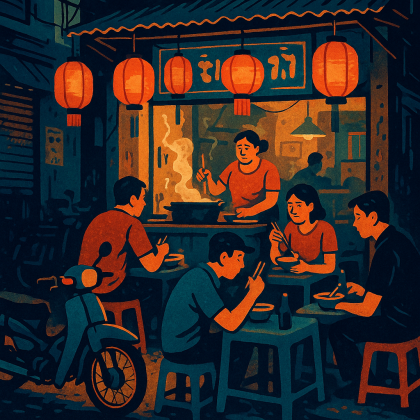
Fuel for the Road, Food for the Soul
Traveling by motorcycle opens up a world that air travel simply can’t offer. It’s a slow journey through shifting terrains, border towns, and forgotten backroads – the kind of travel where you don’t just pass through a country, you absorb it. Unlike the sterilised convenience of airports and shopping malls, riding through rural areas demands real engagement. The need to refuel – not just your bike, but yourself – becomes part of the rhythm of the road.
In obscure villages and roadside stops, there’s often no readable menu, no familiar signage, and sometimes, no menu at all. You eat what’s available. You point, you smile, you trust. Half the time, you don’t even know the name of the dish – but the warmth of a home-cooked meal, prepared with pride and without pretense, tells you everything you need to know. Yet more importantly, amid the unfamiliar, you sometimes encounter something strangely familiar- a dish that reminds you of home, but with a twist. A local version of something you thought you knew, shaped by a different migration route, a different set of ingredients, or adapted to the palate of a new homeland.
A spring roll with a local name and a hint of lemongrass. A familiar bowl of pork rib soup, but with unexpected herbs or spices. These culinary echoes are not accidents – they are living evidence that food transcends borders, as I wrote earlier. Dishes may start with a shared origin, but as they travel – through laborers, traders, and refugees – they transform. They adopt the names, flavours, and customs of the places and people they encounter. What began as one dish becomes many, each variation telling its own story of migration, resilience, and cultural fusion.
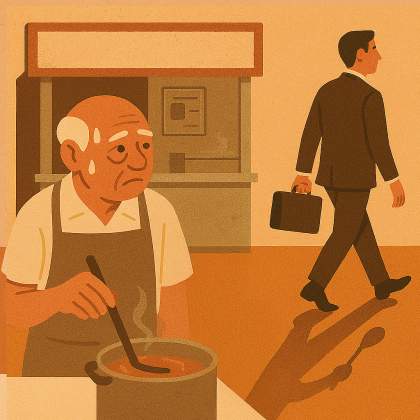
THE COST OF COMMERCIALISATION
Once, the clatter of woks and the rhythm of cooks echoed through hawker centres — food prepared by memory, by feel, and by heart. Today, that sound is slowly being replaced by the hum of uniformed kitchens, templated menus, and operations designed more for consistency than creativity. The landscape of local food is shifting — and not necessarily for the better.
Commercialisation isn’t evil. It brings structure, reach, and scalability. But in the realm of food, it can also dilute. What were once deeply personal recipes handed down across generations have become standardised offerings replicated across outlets. Cooking turns into production; flavour becomes just another deliverable.
The forces behind this shift are easy to trace.Rising rents have pushed out small, independent hawkers from prime locations. Franchise chains, backed by marketing budgets and central kitchens, dominate the spaces where the new generation prefers to dine – air-conditioned malls, transit hubs, and food courts. Even the best efforts to encourage young hawkers – mentorships, subsidies, media spotlights – can’t always overcome the generational reluctance. Many grew up watching their parents toil over boiling pots and blistering stoves, working long hours with little rest or reward. Few wish to inherit that struggle.
We’re not just watching a change in how food is made. We’re watching a quiet erosion of identity — one plate at a time.
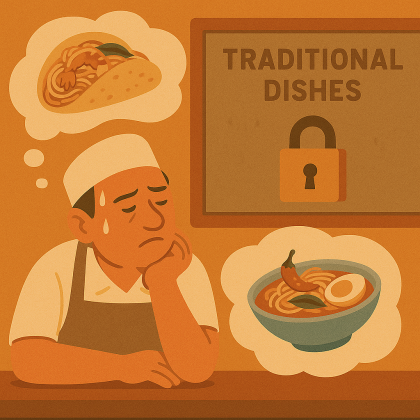
How We Forgot to Cook New Stories
One overlooked reason for the quiet decline of our food culture is the lack of innovation within our own cuisine. While our hawker fare is iconic and deeply loved, it has remained largely unchanged for decades. New creations are rare, and bold experimentation even rarer. In fact, among the few notable local inventions in recent memory are dishes like Cereal Crab, Cereal Prawn, and Salted Egg Yolk Crab — all of which emerged from tze char stalls and gained popularity only in the past few decades. Beyond these, few contemporary dishes have entered the mainstream. This resistance to change isn’t just cultural — it’s systemic. The fear of doing something “wrong” or deviating from the known recipe echoes the “kia-su” mindset, ingrained through years of rigid schooling and a culture that prizes safe success over creative failure.
Meanwhile, we’ve embraced wave after wave of foreign culinary trends with open arms – and mouths. From Bubble Tea to Kebab to Mala Hot Pot, each new arrival is celebrated, franchised, and multiplied across the island. And why not? We are, after all, a nation built by immigrants. Just like our forefathers, today’s new arrivals bring with them a fresh palette of global flavours – all without us needing to leave home.
But there’s a catch. Our enthusiastic embrace of foreign cuisine, while culturally open and commercially savvy, has also unintentionally stifled the growth of local food innovation. Trendy foreign dishes are marketed as modern, cool, and globally relevant – while anything new and local struggles for attention. We’ve become better at consuming than creating. Beyond the handful of heritage dishes tied to our national identity, no new culinary invention has meaningfully emerged to define this generation, as our established local dishes remain so rigidly tied to tradition that evolving them is often perceived as diluting, compromising, or even disrespecting their authentic essence.
So where do we go from here?
The path forward lies in rediscovering the same spirit of adaptation that once gave birth to our hawker heritage. We need to stop treating tradition as a boundary and start seeing it as a launchpad. Empower young chefs to experiment without fear. Create space for food entrepreneurs to try, fail, and try again – without being crushed by rents or drowned by trends. Only then can we begin writing the next chapter of our food story – one that honours our past, but also dares to taste the future.
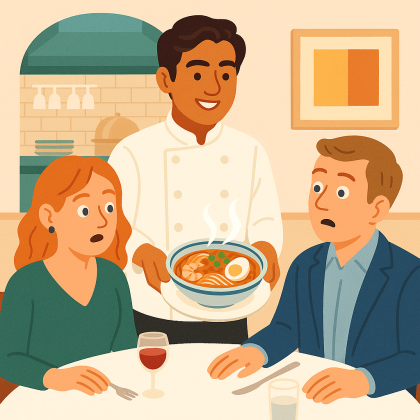
the next course
Commercialisation is no longer just an influence – it’s part of our daily rhythm. It lives in our malls, office towers, and transit hubs. It feeds us in between meetings and errands, delivered in plastic containers and algorithm-driven menus. The “McDonaldisation” of food – fast, efficient, uniform – is here to stay. And for many, it works. It’s predictable. It’s accessible. It’s profitable.
But what it isn’t… is sustainable for those still trying to do it the old way.
Running a hawker stall today is a battle against the tide. The hours are long. The labour is physical. The margins are thin. And while there have been campaigns to encourage a new generation of hawkers, most who tried eventually burnt out — or got lured back into the comfort (or trap) of the rat race. Passion, alone, doesn’t pay rent.
Yet, oddly enough, there’s a flicker of hope – not within our shores, but beyond them. Singapore-themed restaurants and hawker-style eateries are gaining traction abroad. From Los Angeles to London, Bangkok to Brisbane, queues are forming for chilli crab, kaya toast, and Hainanese chicken rice. And with that comes a new wave of cultural curiosity – and yes, the usual debates over where the dishes really come from (usually stirred up by politicians more skilled at grandstanding than grasping gastronomy).
But maybe, just maybe, this is a good thing.
Sometimes, we need to see ourselves from the outside to appreciate what we have. Just like our forefathers who once brought their flavours into new lands, our local cuisine may now find the space to evolve elsewhere – where it’s not bound by nostalgia, tradition, or the “don’t do wrong” mentality. In the diaspora, food becomes flexible again. It adapts. It fuses. It grows.
Perhaps the next version of sambal won’t come from a hawker in Bedok, but from a chef in Berlin. Perhaps the next twist on Laksa won’t be found in a Katong, but in a pop-up in New York. And if that’s what it takes for our culinary story to keep evolving — then maybe the wok doesn’t need saving. It just needs a change of scenery.
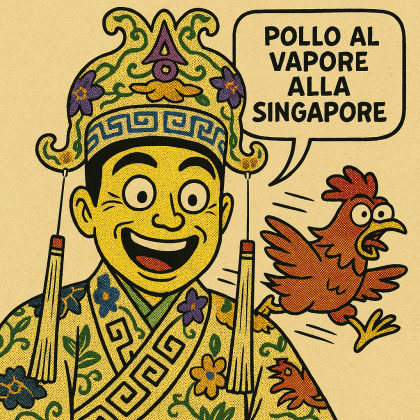
Can Tradition Survive the Trend?
“Fried Rice Paradise” had a rocky start. Rejected by local radio stations for its heavy use of Singlish, it was seen as too informal, too unrefined, too local. And yet, the singer found love abroad – with a fan club in Japan, and even a chartered plane full of female fans flying in for Dick Lee’s concert. Only later was it embraced back home, celebrated for the very things it was once criticised for – its authenticity, its spirit, its unapologetic flavour.
Sounds familiar? Just ask Charlie Chan Hock Chye.
Maybe our local cuisine is on a similar path. Overlooked here, but quietly gaining ground elsewhere. Perhaps it too needs to leave home before it can return with new meaning. And when it does, it won’t just be about preservation – but reinvention. A reminder that what’s truly ours doesn’t fade – it evolves. And sometimes, the only way to find the future of our flavour… is to let it travel first.
